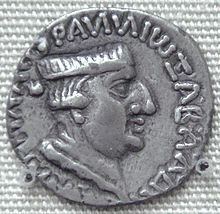Reign 1st or 2nd century CE Parents Bhumaka Grandparent Abhiraka | Died 124 AD | |
 | ||
Similar Vasishthiputra Pulumavi, Vashishtiputra Satakarni, Gautamiputra Satakarni | ||
Kabir bedi as nahapana in gautamiputra satakarni shares his experience with balakrishna and krish
Nahapana (r. 1st or 2nd century CE) was an important ruler of the Western Kshatrapas, descendant of the Indo-Scythians, in northwestern India. According to one of his coins, he was the son of Bhumaka.
Contents
- Kabir bedi as nahapana in gautamiputra satakarni shares his experience with balakrishna and krish
- Period
- Reign
- Guatamiputra Satakarni
- References
Period
The exact period of Nahapana is not certain. A group of his inscriptions are dated to the years 41-46 of an unspecified era. Assuming that this era is the Shaka era (which starts in 78 CE), some scholars have assigned his reign to 119-124 CE. Others believe that the years 41-46 are his regnal years, and assign his rule to a different period. For example, Krishna Chandra Sagar assigns his reign to 24-70 CE, while R.C.C. Fynes dates it to c. 66-71 CE.
Reign
The Periplus of the Erythraean Sea mentions one Nambanus as the ruler of the area around Barigaza. This person has been identified as Nahapana by modern scholars. The text describes Nambanus as follows:
He also established the Kshatrapa coinage, in a style derived from Indo-Greek coinage. The obverse of the coins consists of the profile of the ruler, within a legend in Greek. The reverse represents a thunderbolt and an arrow, within Brahmi and Kharoshthi legends.
Nahapana is mentioned as a donator in inscriptions of numerous Buddhist caves in northern India. The Nasik and Karle inscriptions refer to Nahapana's dynastic name (Kshaharata, for "Kshatrapa") but not to his ethnicity (Saka-Pahlava), which is known from other sources.
Nahapana had a son-in-law named Ushavadata (Sanskrit: Rishabhadatta), whose inscriptions were incised in the Pandu-lena caves near Nasik. Ushavadata was son of Dinika and had married Dakshamitra, daughter of Nahapana. According to the inscriptions, Ushavadata accomplished various charities and conquests on behalf of his father-in-law. He constructed rest-houses, gardens and tanks at Bharukachchha (Bharuch), Dashapura (Mandasor in Malva), Govardhana (near Nasik) and Shorparaga (Sopara in the Thana district). He also campaigned in the north under the orders of Nahapana to rescue the Uttamabhadras who had been attacked by the Malayas (Malavas). He excavated a cave (one of Pandavleni Caves) in the Trirashmi hill near Nasik and offered it to the Buddhist monks.
Guatamiputra Satakarni
Overstrikes of Nahapana's coins by the powerful Satavahana king Gautamiputra Satakarni have been found in a Southern Gujarat hoard at Jogalthambi. This suggests that Gautamiputra defeated Nahapana.
Earlier scholars such as James Burgess have pointed out that it is not necessary that Gautamiputra Satakarni and Nahapana to be contemporaries since Satakarni mentions that the areas he has conquered were ruled by Ushavadata, rather than Nahapana. According to Burgess, there might have been an interval of as much as a century between the reigns of these two kings. However, most historians now agree that Gautamiputra and Nahapana were contemporaries, and that Gautamiputra defeated Nahapana. M. K. Dhavalikar dates this event to c. 124 CE, which according to him, was the 18th regnal year of Gautamiputra. R.C.C. Fynes dates event to sometime after 71 CE.
Nahapana was founder of one of the two major Saka Satrap dynasties in north-western India, the Kshaharatas ("Satraps"); the other dynasty included the one founded by Chashtana.
